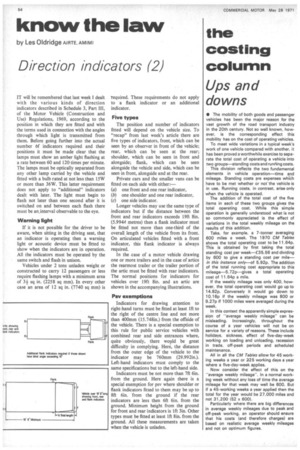the costing column Ups and downs
Page 62

If you've noticed an error in this article please click here to report it so we can fix it.
• The mobility of both goods and passenger vehicles has been the major reason for the vast growth of the road transport industry in the 20th century. Not so well known, however, is the corresponding effect this mobility has on the cost of operating vehicles.
To meet wide variations in a typical week's work of one vehicle compared with another, it has been proved a worthwhile exercise to separate the total cost of operating a vehicle into two groups—standing costs and runriing costs. " This division reflects the two fundamental elements in vehicle operation—time and mileage. Standing costs are expenses which have to be met whether or not the vehicle is in use. Running costs, in contrast, arise only when the vehicle is operated.
The addition of the total cost of the five items in each of these two groups gives the total operating cost. While this simple operation is generally understood what is not so commonly appreciated is the effect of variations in the total weekly mileage on the results of this addition.
Take, for example, a 7-tonner averaging 600 miles a week. The 1970 CM Tables shows the total operating cost to be 11.64p. This is obtained by first taking the total standing cost per week—£35.56 and dividing by 600 to give a standing cost per rnilein this instance only—of 5.92p. The addition of the total running cost appropriate to this mileage-5.721)----gives a total operating cost of 11.64p a mile.
If the weekly mileage was only 400, however, the total operating cost would go up to 14.82p. Conversely it would go down to 10.16p if the weekly mileage was 800 or 9.27p if 1000 miles were averaged during the week.
In this context the apparently simple expression of "average weekly mileage" can be misleading. Increasingly, throughout the course of a year vehicles will not be on service for a variety of reasons. These include holidays, sickness, effect of five-day-week working on loading and unloading, recession in trade, off-peak periods and scheduled maintenance.
All in all the CM Tables allow for 45 working weeks a year or 225 working days a year where a five-day-week applies.
Now consider the effect of this on the "average weekly mileage". In a normal working week without any loss of time the average mileage for that week may well be 600. But if a 45-working weeks a year applied then the total for the year would be 27,000 miles and not 31,200 (52 x 600).
Particularly where there are big differences in average weekly mileages due to peak and off-peak working, an operator should ensure that his costs (and therefore charges) are based on realistic average weekly mileages and not on optimum figures.










































































































